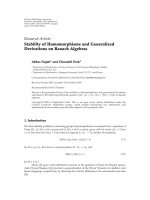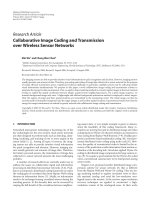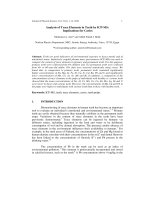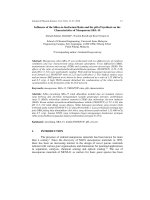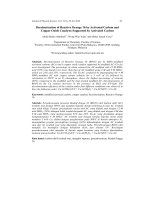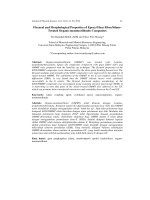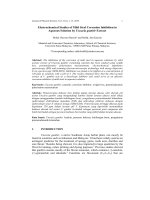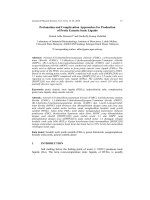Báo cáo vật lý: "SIMULTANEOUS SPECTROPHOTOMETRIC DETERMINATION OF Pb(II) AND Cd(II) USING ARTIFICIAL NEURAL NETWORKS" potx
Bạn đang xem bản rút gọn của tài liệu. Xem và tải ngay bản đầy đủ của tài liệu tại đây (128.6 KB, 10 trang )
Journal of Physical Science, Vol. 18(1), 1–10, 2007 1
SIMULTANEOUS SPECTROPHOTOMETRIC DETERMINATION
OF Pb(II) AND Cd(II) USING ARTIFICIAL NEURAL NETWORKS
Azizul Isha
1
, Nor Azah Yusof
1
*, Mazura Abdul Malik
1
and Hazlina Hamdan
2
1
Department of Chemistry, Faculty of Science,
2
Faculty of Computer Science and Information Technology,
Universiti Putra Malaysia, 43400 UPM Serdang, Selangor, Malaysia
*Corresponding author:
Abstract: A method for simultaneous analysis of Pb(II) and Cd(II) has been developed
by using artificial neural network (ANN). This method is based on the difference
concentration of Pb(II) and Cd(II) with 4-(2-pyridylazo)-resorcinol (PAR). A feed
forward neural network using back-propagation (BP) algorithm has been employed in
this study. The input layer consists of seven neurons, six neurons of hidden layer and two
output neurons was found appropriate for the simultaneous determination of Pb(II) and
Cd(II). The network was trained up to 20 epochs with 0.0001% learning rate. This
reagent also provided good analytical performance with reproducibility characters of the
method yield relative standard deviation (RSD) of 0.44% and 0.94% for Pb(II) and
Cd(II), respectively. The limit of detection of the method for Pb(II) and Cd(II) was
calculated to be 1.9 and 0.4 mg/l, respectively.
Keywords: Pb(II), Cd(II), simultaneous determination, artificial neural networks,
spectrophotometry, PAR
1. INTRODUCTION
More recently, the application of artificial intelligence or expert systems
in analytical chemistry and chemical engineering has emerged rapidly. ANN is a
computing system made up of a number of simple and highly interconnected
processing elements, which processes information by its dynamic state response
to external inputs.
1
Pb(II) and Cd(II) are metals that appear together in many real samples.
Several techniques such as flame atomic absorption,
2
voltammetric
3
and
spectrophotometric
4,5
methods have been used for the determination of these ions
in different samples. Among this, uv-visible spectrophotometry is the most
commonly used techniques for Pb(II) and Cd(II).
It is more favorable because of its simplicity, acceptable precision and
accuracy, low cost and it has a good sensitivity,
6
but the simultaneous
determination of these ions by the used of traditional spectrophotometry is
difficult. Generally, the overlap of the absorption spectra and the superimpose
Simultaneous Spectrophotometric Determination of Pb(II) and Cd(II) 2
curves are not suitable for quantitative evaluation. Quantitative
spectrophotometry has been improved by the use of multivariate statistical
method, particularly principal component regression and artificial neural network
(ANN).
7
ANN has been widely used in chemical application such as interpretation
of spectra, calibration, process control, molecular dynamics, optimization of the
linear signal range, signal processing and modeling structure of protein.
8–10
Rezaie et al.
7
has studied the simultaneous determination of cobalt(II) and
nickel(II) based on formation of their complexes with pyrolidine and carbon
disulfide. They found that, 42 neurons in the input layer and 60 neurons in the
hidden layer was successfully applied in simultaneous determination of Co(II)
and Ni(II).
7
The aim in this study was the simultaneous determination of Pb(II) and
Cd(II) by uv-visible spectrophotometry in some complex mixture using 4-(2-
pyridylazo)-resorcinol (PAR), which is a popular reagent in spectrophotometric
determination of different metal ion such as Pb(II) and Cd(II) using ANN.
2. EXPERIMENTAL
All chemicals were of analytical reagent grade and deionized water was
used throughout the experiment. Stock standard solution (1000 mg/l) of Pb(II)
and Cd(II) was prepared by dissolving 1.1261 g of Pb(NO
3
)
2
(Fluka AG) and
1.0271 g of Cd(NO
3
)
2
. 4H
2
O (Hamburg) in 1000 ml volumetric flasks and
diluted to the mark with deionized water. PAR (BDH Chemical Ltd.) was used as
a reagent. 0.001 M PAR stock solution was prepared by dissolving 0.2152 g of
PAR powder in 1000 ml ethanol (95%) (Prochem). A series of standard solution
were prepared by appropriate dilution of stock solution.
2.1 Instrumentation
Spectral measurements were made with a uv-visible spectrophotometer
(Varian-Cary Win UV 100). For each concentration, the spectrum was scanned
in the wavelength of 350–750 nm. A total of 18 spectral reading were obtained.
Three of these spectra were used for testing the trained network whilst the
remaining spectra were used for the training of the network.
Journal of Physical Science, Vol. 18(1), 1–10, 2007 3
2.2 Procedure
Sample solutions were prepared in 25 ml volumetric flask by taking a
required volume of the solution to be analyzed to obtain Pb(II) and Cd(II)
concentrations over this respective determination ranges 1–15 mg/l for Pb(II) and
2–16 mg/l for Cd(II). Then 0.6 ml buffer solution (boric acid and borax (0.2 M))
and 1.5 ml PAR were added. The solution was then diluted to the mark. The
absorbance spectra of the complex solution were recorded from 350 to 700 nm.
2.3 Data Treatment and Data Analysis
A feed-forward ANN having a single hidden neuron layer with back-
propagation (BP) training algorithm was employed for treatment of the data.
The structure of BP algorithm comprised of three layers, input, output and hidden
layer. Figure 1 shows the architecture of the ANN. The input layer consists of
seven neurons, which represent the absorbance intensities measured at seven
different wavelengths from each spectrum. The output layer consists of two
neurons which represent the concentration
value of Pb(II) and Cd(II).
Figure 1: Schematic representation of a three layer artificial neural network
The network training and data treatment were realized by using
MATLAB program
11
under an Intel Celeron processor having 256 MB of RAM.
The training and optimization process carried out in this study is shown in Table
1. Network optimization was performed by changing the number of neuron in the
hidden layer, the number of cycles during training and the percentage of learning
rate. Network having from 5 up to 17 neurons in hidden layer has been
considered in this study. Network trained with 20 epochs were used to predict the
response of the concentration of Pb(II) and Cd(II). The mean-squared error
(MSE) for training was measured at the end of the epochs by the MATLAB
program to show the goal of the training achieved. Finally, a new set of input
Simultaneous Spectrophotometric Determination of Pb(II) and Cd(II) 4
data i.e., other absorbance intensities were introduced to the networks to check
for its prediction capability and precision.
Table 1: The general setting of the BP specific parameters during network
training
Specific parameters Values
Maximum number of epochs to train 20
Sum-squared error (SSE) goal 0.02
Learning rate 0.0005
The preference of the best network was based on several tests using the
trained network that incorporates the inspection for training data fitting errors
and prediction test of errors. The selected network was then applied for
computer-generated application where new measurement were taken, processed
and converted to concentration values employed by the MATLAB program
simulation.
3. RESULTS AND DISCUSSION
Pb(II) and Cd(II) reacted with PAR to form a complex. Figure 2 shows
the spectra of these complexes. The absorption maximum for Pb(II)-PAR and
Cd(II)-PAR is 518 and 409 nm, respectively. Figure 3 shows the 3D absorbance
spectra of mixture of Pb(II) and Cd(II) after reaction with PAR at different
concentration of Pb(II) and Cd(II).
Figure 2: Absorption spectra for (a) Pb(II)-PAR complex, (b) Cd(II)-PAR
complex, and (c) mixture of Pb(II) and Cd(II)
Journal of Physical Science, Vol. 18(1), 1–10, 2007 5
Figure 3: Generated 3D absorbance spectra for mixture of Pb(II) and Cd(II) after
reaction with PAR at different analyte concentration
The method developed produced a linear response when the Pb(II)
concentration is within the range of 1–10 mg/l, then almost constant in the range
of 40–60 mg/l. The limit of detection of the method was calculated to be
1.9 mg/l.
The method developed produced a linear response when the Cd(II)
concentration is within the range of 1–10 ppm. The limit of detection was
calculated to be 0.4 mg/l.
Data obtained from uv-visible spectrophotometer were used as the input
to the ANN. Only seven wavelengths points (370, 405, 430, 450, 500, 519 and
550 nm) from each spectrum were chosen to represent the input data for the
ANN to avoid several problem during network training period.
Fifteen spectra were used for the training of the ANN and three spectra
were used for prediction. Network optimization was performed by
changing the
number of neuron in the hidden layer, the number of cycle during training and
the percentage of learning rate.
Table 2 shows the MSE values of the network with 5–17 hidden neurons
after completing the 20 epochs. The number of hidden neurons when arranged in
declining MSE order was 8, 10, 14, 7, 17, 5 and 6. Figure 4 shows the MSE
Simultaneous Spectropho
tometric Determination of Pb(II) and Cd(II) 6
versus the number of neurons in the hidden layer, required to get fixed (2%)
error. The results show that, by increasing the number of neuron from 6 to 8, the
MSE value increased and then, decreased. Six neurons of hidden layer performed
the lowest MSE value. This result agreed well with the results reported by Taib
and Narayanaswamy which reported that an optimized and suitable network can
be attained with network size of 6–17 neurons in hidden layer.
13
Table 2: MSE values of the networks with 5–17 hidden neurons
0.000
0.005
0.010
0.015
0.020
0 5 10 15
Number of neurons (hidden layer)
Mean-square error (MSE)
20
Figure 4: The relationship between numbers of neuron in hidden layer versus
MSE
Number of neuron
in the hidden layer
MSE
5 0.01223
6 0.01175
7 0.01521
8 0.01836
10 0.01645
14 0.01545
17 0.01233
Pb(II) Cd(II)
Table 3: The network of Pb(II) and Cd(II) concentration using calibration data
Note:
a
Average calibration error = |predicted V(V) concentration – expected V(V) concentration| / 3
Hidden
layer
size
Expected 4.0 Expected 9.0 Expected 14.0 Expected 5.0 Expected 10.0 Expected 15.0
Average
calibration
error
a
Predicted Error Predicted Error Predicted Error Predicted Error Predicted Error Predicted Error
5
1.2 2.8 12.7 3.7 14.0 0 3.2 1.8 11.0 1.0 15.1 0.1 1.567
6
3.0 1.0 8.3 0.7 15.0 1.0 4.6 0.4 9.2 0.8 15.7 0.7 0.767
7
4.8 0.8 8.4 0.6 13.6 0.4 5.4 0.4 12.2 2.2 14.6 0.4 0.800
8
6.4 2.4 14.2 5.2 14.2 0.2 4.2 0.8 13.3 3.3 14.5 0.5 2.067
10
4.1 0.1 6.5 2.5 14.1 0.1 5.7 0.7 13.9 3.9 14.7 0.3 1.267
14
8.9 4.9 9.0 0 8.8 5.2 6.2 1.2 6.5 3.5 16.0 1.0 2.633
17
6.1 2.1 10.2 1.2 17.7 3.7 7.0 2.0 8.2 1.8 14.9 0.1 1.816
Simultaneous Spectrophotometric Determination of Pb(II) and Cd(II) 8
Network trained with 20 epochs were suitable to be used in predicting the
response of the concentration of Pb(II) and Cd(II) since it showed a low MSE
value. Zupan and Gasteiger
8
reported that, ANN training by using much higher
number of epochs usually caused problems such as over training and over fitting
problems. Three calibration spectra of Pb(II) and Cd(II) were employed to
establish their prediction capability. The trained networks with different number
of hidden neurons were present to improve the process in choosing the best
network’s architecture.
13
Table 3 shows the predicted concentration values against the expected
concentration values as measured by uv-visible spectrophotometer. As shown,
the network with 6 neurons in hidden layer produced the good predictions results
with average calibration errors of 0.767. Figures 5 and 6 show the training data
fitting and calibration by the network with 6 neurons in hidden layer for Pb(II)
and Cd(II), respectively.
4. CONCLUSION
The most important aspect of this work is the possibility of simultaneous
determination of Pb(II) and Cd(II). A network architecture consisting 7 input
neurons, 6 neurons of hidden layer and 2 output neuron after completing the 20
epochs with 0.0001% learning rate was found appropriate for the simultaneous
determination of Pb(II) and Cd(II). The average calibration error was found to be
0.767 for simultaneous determination of Pb(II) and Cd(II). The proposed method
has been applied successfully to the simultaneous determination of Pb(II) and
Cd(II) in some complex mixture.
5. ACKNOWLEDGEMENTS
The author would like to acknowledge Ministry of Environmental and
Science of Malaysia for funding this research through IRPA research grant IRPA
09-02-04-818-EA001.
Figure 4: Training data fitting and calibration of Pb(II) concentration by the
network with six neurons in hidden layer
Figure 5: Training data fitting and calibration of Cd(II) concentration by the
network with six neurons in hidden layer
Simultaneous Spectrophotometric Determination of Pb(II) and Cd(II) 10
6. REFERENCES
1. Wasserman, P.D. (1989). Neural computing: Theory and practice. New
York: Van Nostrand Reinhold.
2. Lemos, V.A. & Ferreira, S.L. (2001). Online preconcentration system for
lead determination in seafood samples by flame atomic absorption
spectrometry using polyurethane foam loaded with 2-(2-
benzothiazolylazo)-2-p-cresol. Anal. Chim Acta, 441(2), 281–289.
3. Eisner, E.K., Brand, M. & Tzur, D. (1999). Determination of sub-
nanomolar concentration of lead by anodic stripping voltammetry at the
silver electrode. Anal. Chim Acta, 385(1–3), 325–335.
4. Ahmed, M.J. & Al-Mamun, M. (2001). Spectrophotometric
determination of lead in industrial environmental, biological and soil
samples using 2,5-dimercapto-1,3,4-thiadiazole. Talanta, 55(1), 43–54.
5. Hashem, E.Y. (2002). Spectrophotometric studies on the simultaneous
determination of cadmium and mercury with 4-(2-pyridylazo)-resorcinol.
Spectrochimica Acta Part A, 58, 1401–1410.
6. Stokinger, H.E. (1981). Patty’s industrial hygiene and toxicology (Vol.
2A, 3
rd
ed.). New York: Wiley-Interscience, 2028.
7. Rezaei, B., Ensafi, A.A. & Shandizi, F. (2001). Simultaneous
determination of cobalt and nickel by spectrophotometric method and
artificial neural network. Microchemical Journal, 70, 35–40.
8. Zupan, J. & Gasteiger, J. (1991). Neural network: A new method for
solving chemical problems or just a passing phase. Anal. Chim. Acta.,
248, 1–30.
9. Zupan, J. & Gasteiger, J. (1993). Neural networks for chemists: An
introduction. Weinheim: VCH Publishers.
10. Cirovic, D.A. (1997) Feed-forward artificial neural networks:
Applications to spectroscopy. Trend. Anal. Chem., 148–155.
11. The MathWorks Inc. (2003). Matlab, rapid data. Worthing, UK: Author.
12. Garg, D.P. & Bozink, J.S. (1972). Parameter estimation of non-linear
dynamical systems. Int. J. Control., 15, 1121–1127.
13. Taib, M.N. & Narayanaswamy. R, (1997). Multichannel calibration
technique for optical-fibre chemical sensor using artificial neural
network. Sensors and Actuators B, 38–39, 365–370.
